Today, the concept Biodiversity Net Gain (BNG) has become increasingly common due to the acknowledgement of biodiversity being greatly important to our existence.
Thus, it seems appropriate to provide a definition: BNG is an approach to development that aims to leave the natural environment in a measurably better state than it was before. It is an approach whereby various stakeholders aim to minimise impacts and maximise outputs for biodiversity.
At present, around 100 countries have a strong policy requirement to achieve a net gain in biodiversity; England being one of the most recent, as a result of the 2019 Environment Bill. England is in the process of enforcing BNG through the planning system because it has recognised that biodiversity loss due to development is unsustainable.
Effective in November 2023, the planning process mandates that if the value of any habitat that is lost, it must be replaced to its original level, plus a 10% net gain, either on-site or another location (off-site).
For some developers, it is less profitable to replace or improve the biodiversity on-site, so they tend to favour replacing biodiversity elsewhere. This is good news for farmers and landowners because it presents a market opportunity for an alternative income stream.
Any biodiversity improvements made by farmers and landowners are able to be quantified (DEFRA has developed a biodiversity metric) and bought by developers – a win-win; not only does the biodiversity improve on the farm, but farmers also get paid for it.
Although, not yet compulsory in Scotland, we are seeing more and more developers undertaking BNG on a voluntary basis, and therefore farmers developing an interest in what it could mean for them.
Whether delivered through planning legislation, or through maturing natural capital free markets, BNG could help reach the target of being net-zero by 2045, fulfil Scotland’s Biodiversity Strategy, and generate alternative income for farmers.
- Natural Capital: The expert advisers at Galbraith guide our clients in realising value in all land uses – by assessing and measuring natural assets, furthering opportunities in biodiversity net gain, and ensuring stakeholders are rewarded fully for their investment in and contribution to delivering ecosystem services and net-zero outcomes.

